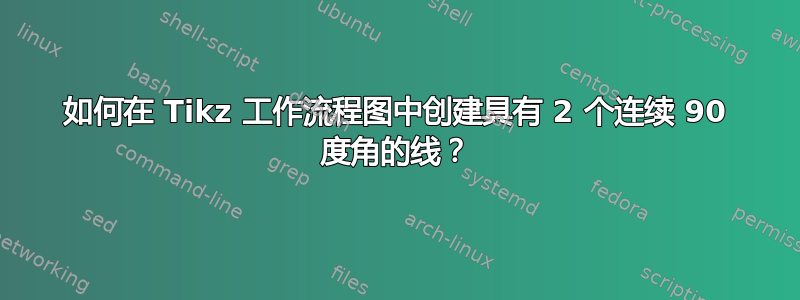
我在尝试将决策节点与第二个流程节点连接时遇到了一些问题。具体来说,我希望有一条水平线,后面跟着一条垂直线和另一条水平线 (- | -)。
此外,我想根据工作流的中心轴将工作流居中。相反,Latex 会同时考虑侧箭头,将它们居中。有什么建议吗?
非常感谢能够回答的人。
\begin{tikzpicture}[node distance=2.7cm]
\node(pro1) [forno]{Trattamenti Termici};
\node(pro2) [process, below of=pro1]{Lavorazioni Meccaniche};
\node(dec) [decision, below of=pro2, text width=4cm, yshift=-1.5cm]{Il ciclo prevede ulteriori fasi di TT?};
\node(stop) [startstop, below of=dec, yshift=-1.8cm]{M10};
\node[
draw,
densely dotted,
red,
inner sep=8pt,
fit={(pro2) (stop)},
] (fit) {};
\node[above right, inner sep=0pt] at (fit.north west) {UME Nord};
\draw[arrow] (pro1) -- (pro2);
\draw[arrow] (pro2) -- (dec);
\draw[dashed, ->] (dec) -- ++ (3cm,0) node[anchor=east] [above,pos=0.25]{Sì} (pro1);
\draw [dashed, ->] (dec) -| (pro2);
\draw[arrow] (dec) -- node[anchor=south] [left,pos=0.25]{No} (stop);
\end{tikzpicture}
答案1
- 请始终提供 MWE(最小工作示例),以便我们可以按原样测试您的文档示例(类似于下面的 MWE)
- 不太清楚反馈回路应该放在哪里。我猜如下图所示。
- 我提出两个建议。第一个是“经典”,第二个则更“花哨”(正如@Qrrbrbirlbel 在他的一个回答中所建议的那样):
\documentclass[margin=3mm, varwidth=66mm]{standalone}
\usepackage{tikz}
\usetikzlibrary{chains,
ext.paths.ortho, % -|- and |-| path operations
fit,
positioning,
quotes,
shapes.geometric}
\begin{document}
\begin{tikzpicture}[
node distance = 8mm and 12mm,
start chain = A going below,
base/.style = {draw, fill=#1,
text width=32mm, minimum height=7mm,
align=center},
startstop/.style = {base=red!30, rounded corners},
process/.style = {base=orange!30},
io/.style = {base=blue!30,
trapezium, trapezium stretches body,
trapezium left angle=70, trapezium right angle=110},
decision/.style = {base=green!30, diamond, aspect=1.7, inner xsep=-3pt},
FIT/.style = {draw=red, densely dotted, inner xsep=8mm,
fit=#1},
lb/.style = {label={[lbl, anchor=north west]south:#1}},
ll/.style = {label={[lbl, anchor=south east]west:#1}},
arr/.style = {semithick,-latex},
]
\begin{scope}[nodes={on chain, join=by arr}]
\node [process] {Trattamenti Termici};
\node [process] {Lavorazioni Meccaniche};
\node [decision] {Il ciclo prevede ulteriori fasi di TT?};
\node [startstop] {M10};
\end{scope}
\node[FIT={(A-2) (A-4)},
label={[anchor=south west]north west:UME Nord}] (f1) {};
\draw[arr,dashed] (A-3.east) -|-[distance=-20mm] (A-2.east) % feedback loop
node[pos=0.1, above] {Sì};
\path (A-3) to ["No"] (A-4);
\end{tikzpicture}
\bigskip
or a bit more fancy
\bigskip
\begin{tikzpicture}[
node distance = 8mm and 12mm,
start chain = A going below,
base/.style = {draw, fill=#1,
text width=32mm, minimum height=7mm,
align=center,
on chain=A},
startstop/.style = {base=red!30, rounded corners},
process/.style = {base=orange!30},
io/.style = {base=blue!30,
trapezium, trapezium stretches body,
trapezium left angle=70, trapezium right angle=110},
if/.style = {base=teal!30, align=left, align=flush center,
label={[D=teal]north east:}},
D/.style = {diamond, draw=#1, fill=#1!60, inner sep=1.6mm,
anchor=center},
lbl/.style = {inner sep=3pt, font=\small, text=black!75},
lb/.style = {label={[lbl, anchor=north west]south:#1}},
ll/.style = {label={[lbl, anchor=south east]west:#1}},
lr/.style = {label={[lbl, xshift=2mm, anchor=south west]east:#1}},
FIT/.style = {draw=red, densely dotted,
inner xsep=6mm, inner ysep=2mm,
fit=#1},
arr/.style = {semithick,-latex}
]
\begin{scope}[nodes={join=by arr}]
\node [process] {Trattamenti Termici};
\node [process] {Lavorazioni Meccaniche};
\node [if,
lb=Si,
lr=No] {Il ciclo prevede ulteriori fasi di TT?};
\node [startstop] {M10};
\end{scope}
\node[FIT={(A-2) (A-4)}] (f1) {};
\node[above right] at (f1.north west) {UME Nord};
\draw[arr,densely dashed] (A-3.east) -|-[distance=10mm] (A-2.east); % feedback loop
\end{tikzpicture}
\end{document}
附录:
甚至更加“经典”......无需使用库ext.paths.ortho,:
\documentclass[margin=3mm, varwidth=66mm]{standalone}
\usepackage{tikz}
\usetikzlibrary{chains,
fit,
positioning,
quotes,
shapes.geometric}
\begin{document}
\begin{tikzpicture}[
node distance = 8mm and 12mm,
start chain = A going below,
base/.style = {draw, fill=#1,
text width=32mm, minimum height=7mm,
align=center},
startstop/.style = {base=red!30, rounded corners},
process/.style = {base=orange!30},
io/.style = {base=blue!30,
trapezium, trapezium stretches body,
trapezium left angle=70, trapezium right angle=110},
decision/.style = {base=green!30, diamond, aspect=1.7, inner xsep=-3pt},
FIT/.style = {draw=red, densely dotted, inner xsep=8mm,
fit=#1},
lb/.style = {label={[lbl, anchor=north west]south:#1}},
ll/.style = {label={[lbl, anchor=south east]west:#1}},
arr/.style = {semithick,-latex},
]
\begin{scope}[nodes={on chain, join=by arr}]
\node [process] {Trattamenti Termici};
\node [process] {Lavorazioni Meccaniche};
\node [decision] {Il ciclo prevede ulteriori fasi di TT?};
\node [startstop] {M10};
\end{scope}
\node[FIT={(A-2) (A-4)},
label={[anchor=south west]north west:UME Nord}] (f1) {};
\draw[arr,dashed] (A-3.east) to["Si"] ++ (1,0) |- (A-2); % feedback loop
\path (A-3) to ["No"] (A-4);
\end{tikzpicture}
\end{document}
结果与上面的第一张图像非常相似。




